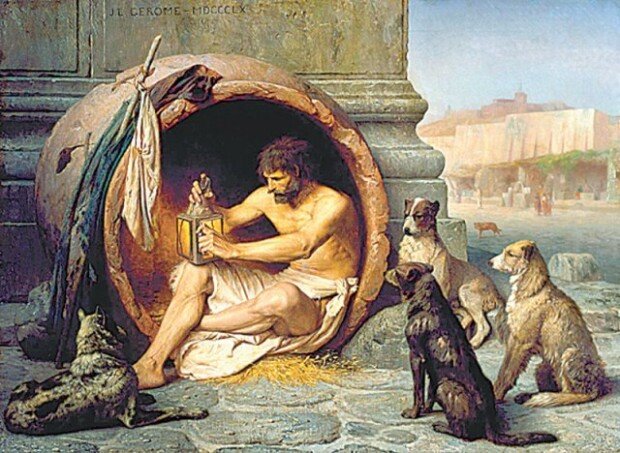Life like dog’s
Life like dog’s
Posted September. 22, 2022 08:05,
Updated September. 22, 2022 08:05

A heavily bearded man is sitting in an old pot. He is half naked and holding a lantern in his hand even though it’s the middle of the day. Four dogs surrounding him are looking at him. He looks like a beggar at a glance. He is indeed the Greek philosopher Diogenes. Why is he looking shabby and surrounded by dogs?
Jean-Leon Gerome who created the painting is an artist that represented the mid-19th century French academy art. Gerome was one of the three prestigious professors at the National School of Fine Arts in Paris and was even called to be one of the most famous living painters in his 50s. He created the painting in his mid-30s before he became a professor.
Diogenes is a philosopher of the cynic (kynikos in Greek) school. The Greek word ‘kynikos’ means ‘dog-like.’ The school emphasized disregarding societal customs and systems and refusing secular desires to live simply and be content in nature. Like dogs. Diogenes only owned a pair of clothes, a lantern, and a cane. The reason why he lit his lantern in the daytime is to find an honest person. However, he doesn’t seem so optimistic. His only companions, dogs, seem to say that there is no human as honest as we are. Surely, there is no being that is as true to its instincts and honest as dogs. They wag their tails to those who feed them and bite those who are bad. They follow their instincts without giving much thought. The painter seems to say through the painting that happiness is being content at the moment without greed and not being ashamed of poverty.
Unlike the philosopher in the painting, the artist himself pursued wealth and fame. He became a professor at the National School of Fine Arts three years later after he created this painting. He taught over 2,000 students during his 40 years at the school and his influence grew both domestically and overseas. However, when impressionism became mainstream, his paintings were quickly forgotten in history. The philosopher who lived like a dog and the painter who pursued success – who do you think was happier?
Headline News
- Korean business leaders urge a halt to commercial law amendment
- Yoon begins extensive verification for cabinet and staff reshuffle
- Police confirm Pyongyang’s involvement in Ether heist in 2019
- Ukraine fires British Storm Shadows at targets on Russian territory
- Ulsan and Pohang compete to crown Korea’s soccer champions







